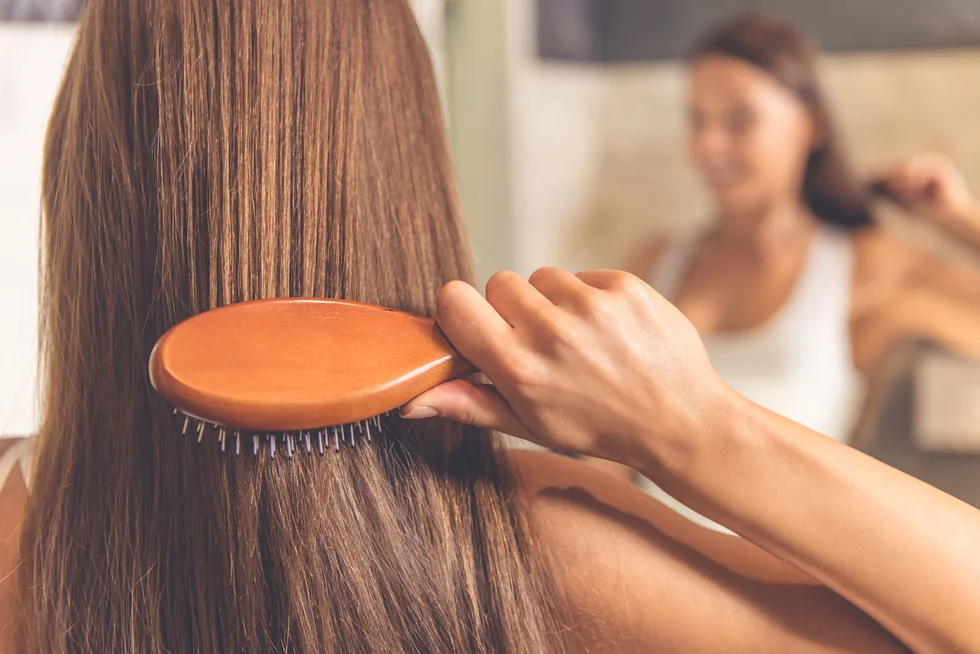Brushing your hair seems like a no-brainer, right? You simply grab the brush from the bathroom drawer and stroke away at your mane. Stop right there.
There is a wrong and a right way to complete this seemingly simple act. Brushing hair improperly could damage your strands, causing hair issues like breakage or tangles. Doing it correctly can leave you with hair that's soft, shiny and strong.
Here are some common hair-brushing mistakes you may be committing that you don't even realize.
You're using the wrong brush.
Brushes don't follow the mantra of one-size-fits all. Test a brush before you use it. It shouldn't feel painful or rough and should complement your hair's texture and the style you desire. Round and metal brushes add volume while blow drying. If your hair is curly or coarse, use a tough or boar bristle brush that has enough tension to pull through your hair. Flat ones are best for sleeker finishes. A flat, paddle-shaped brush is good if you want to put hair into a ponytail or an up-do. Avoid brushes with balls at the end of each bristle. Your hair may wrap around the balls and get ripped out. Your best bet is to use a bristle brush or comb with staggered teeth. These tools relieve knots without tearing out your hair.
You're not brushing enough.
Brushing your hair gently a few times a day is good for it, especially if it's long. It helps condition strands, distributing oils and promoting a healthy scalp.
You're brushing too much.
Three or four strokes are typically enough to remove any knots or fix your style. The more you brush, the more damage you're potentially doing to your mane.
You're just brushing the ends.
Your scalp's natural oils are a great conditioner. Brushing your hair adds natural luster to your locks.
You use the same brush whether your hair is wet or dry.
Wet hair is prone to breakage. Use a comb or brush designed to gently detangle wet hair. Tools geared for wet hair typically have flexible bristles that won't break or tug wet strands.
You don't brush your hair before you wash it.
Prevent tangled hair in the shower by brushing your hair before you hop in to shampoo. Because hair is weakest when it's wet, brush hair thoroughly before you suds up. This practice will help prevent tangling and knotting.
You're brushing your hair when it's wet.
Like we said, your hair is weakest, fragile and most vulnerable when it's wet. So, before reaching for your brush, detangle and smooth your hair with your fingers. That method is gentler than immediately using a comb and may help you avoid damaging your hair.
You're brushing it in the wrong direction.
Brushing hair from top to bottom causes more knots and creates unnecessary damage and breakage. When untangling hair, start a few inches from the bottom (the ends) and work your way up (to the roots). Move closer to your scalp once you've taken care of all the tangles in the section you're working with. (Don't avoid the top of your head altogether; brushing your roots helps redistribute natural oils, conditioning the hair and keeping it healthy.) This way, you won't pull on it, causing unnecessary stress on your mane and possible damage like breakage. If you go down the entire length of your hair in one swipe, you're bound to snag your brush on a tangle and hair can snap. Following this method, hair will eventually be fully detangled and you'll be able to smoothly brush it from scalp to tip.
You're brushing through dry curls.
If you're curly haired, avoid brushing through dry curls. Opt for combs instead of brushes. Brushing curls can aggravate the hair cuticle and even break off the curls. Instead, use a wide-tooth comb to detangle strands when they're wet.







